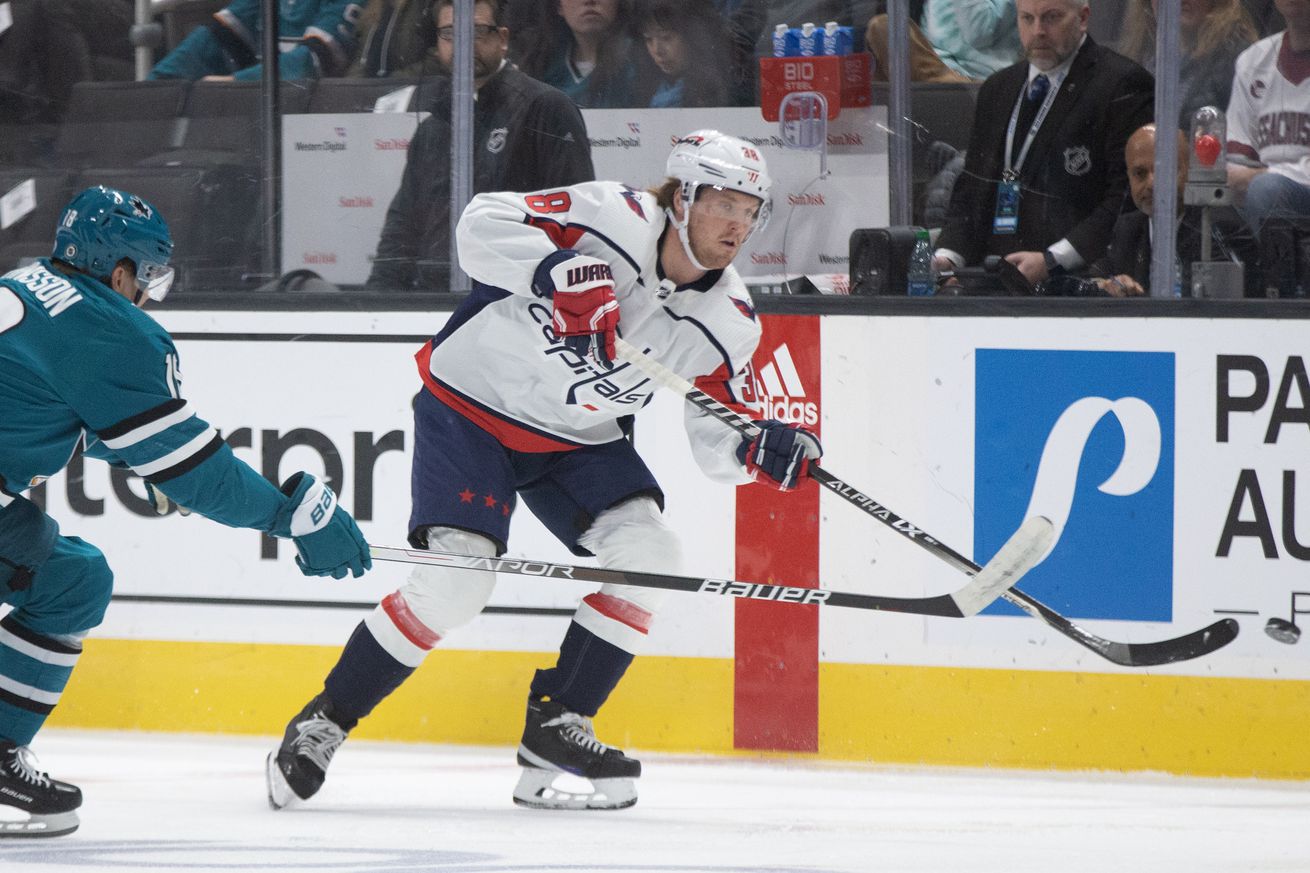
Some believe Sandin is more a product of his team and deployment but is he more than that?
General Manager Brian MacLellan clearly wasn’t going to wait until the summer to start getting the Capitals younger, faster, and better, as he sent Boston’s 2023 first-round pick and Erik Gustafsson to Toronto last week for a soon-to-be 23-year-old, smooth-skating, hard-hitting, and offensively skilled defensemen in Rasmus Sandin. He is exactly the kind of player the Capitals need going forward: young, skilled, cheap and with the potential to get better in the years ahead.
Sandin dressed for his first game with the Capitals on Saturday night against the San Jose Sharks and he quickly showed why MacLellan was so adamant about acquiring him. Sandin showed off all of the skills that made him an attractive target, racking up three assists and coming out on the positive end of possession.
Sandin admitted he played poorly in the first period but as the game went on he got better, which is expected when playing your first game with a new team. The fact he put up three assists while “playing poorly” can only be a good sign.
But that is just one game against a bad Sharks team. How good is Sandin and how high is his ceiling? And was he worth trading a first round pick in a strong draft for? Let’s take a look.
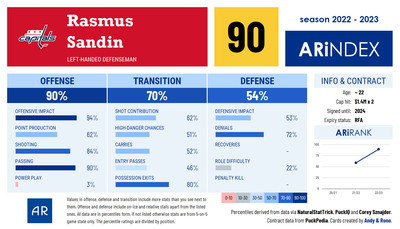
Using Andy and Rono’s player card from this season for Sandin, it gives a pretty good idea of his strengths and weaknesses. When it comes to offense, Rasmus thrives, which makes it all that much stranger that his power play impact is poor…but more on that in a second. His transition skills are pretty darn good too, specifically his possession exits, which is something that the Caps desperately need from their back end. The defensive side also looks strong, although not high end. The fact that his denial numbers look good is a big positive after losing Dmitry Orlov, who was so good at it. The role difficulty can certainly cause concern, but we’ll tackle that later as well.
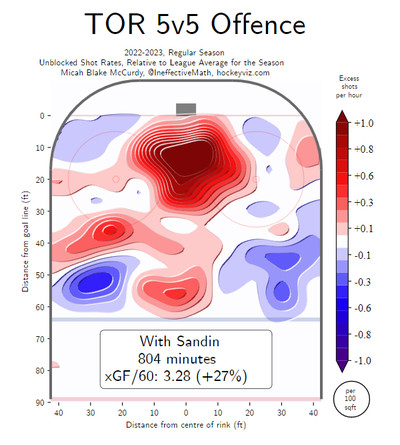
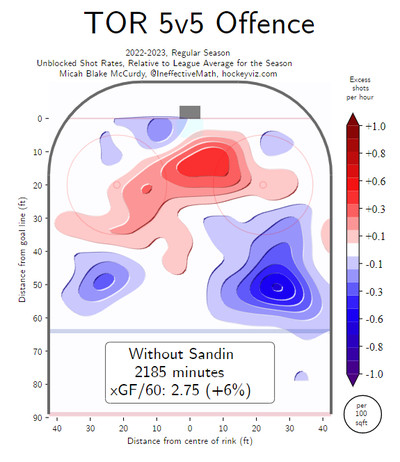
His offensive impacts, according to HockeyViz, are elite. When he was on the ice, the Leafs were creating high-danger shots consistently. Look at all that red! When’s he was off the ice, the Leafs are still creating but not even close to what happens when Sandin is on the ice. As for defensively, whether he was on or off the ice, the Leafs stayed at -6%, which is good, but shows he doesn’t impact the defense all that much.
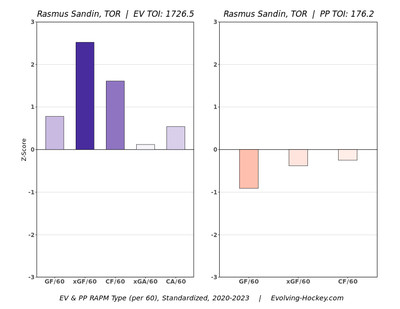
Evolving Wild’s RAMP chart above shows similar info to what is on Andy and Rono’s player card but it also shows just how good Sandin’s offense has been – not just this season, but the last three seasons combined. It also reiterates he’s good but not great on defensive impacts early in his career.
Back to his power-play numbers – they are below-average, but that isn’t too concerning, because 1) even-strength results are much more important and 2) as long as John Carlson is with the Caps, there’s no need for any other defender to really step into that role. It’s worth mentioning that if Sandin had received first-unit power-play time, his numbers would probably look better – and he might get some with Carlson still out and Orlov and Gustafsson no longer with the team, so stay tuned there.
Let’s dive into the raw numbers a bit more using NaturalStatTrick and see how Sandin has done compared to the rest his Toronto Maple Leaf teammates over the last 3 Seasons (112 games played). Relative to his teammates who played at least 45 games, Sandin ranks as the following:
- +2.74CF% – fifth (first among defensemen)
- +5.13xGF% – fifth (first among defensemen)
- +4.89SCF% – fourth (first among defensemen)
- +6.22HDCF% – third (first among defensemen)
- 50.75% offensive zone start – 14th (fifth among defensemen)
So not only has Sandin been top-five in all the major possession stats (shot attempts, expected goals, scoring chances, high danger chances), but he was first among all defensemen on the team. And he’s done it while not being given pure offensive zone starts.
And just to throw it in, over the last three seasons, among ALL defensemen in the league who have played at least 500 minutes, this is how his relative stats rank:
- +2.74CF% (33rd)
- +5.13xGF% (10th)
- +4.89SCF% (12th)
- +6.22HDCF% (6th)
That’s absolutely superb. If you say there are roughly 60ish top-pairing defensemen in the league (give or take, it’s not an exact science) then Sandin has been putting up numbers like a top-pairing defensemen.
To add to this, over the last three seasons, Sandin has been the fifth-best player and second-best defensemen on the Maple Leafs in xGAR (provided by Evolving Wild).
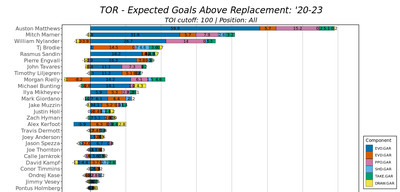
Among all defensemen in the league, he ranks 28th in xGAR over the last three seasons, which is just really impressive.
There is one caveat. According to JFresh’s player card below, this season, Sandin’s “Competition” is in the 44 percentile of difficulty and his TOI shows he gets third-pairing minutes. It’s great Sandin is putting up stellar numbers, but he’s done so in fairly sheltered minutes. So wondering how will he do against the tougher opponents in tougher minutes is a valid question.
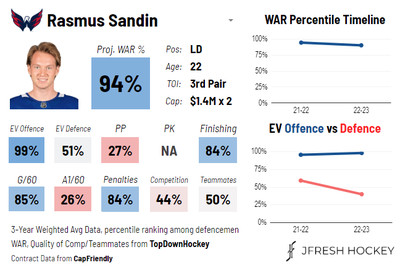
Of course, just because Sandin doesn’t consistently go up against top-tier opponents, doesn’t mean he never has. In fact, over the last three seasons, according to PuckIQ, Sandin has played almost 400 minutes against “elite competition” – not a ton, but it’s still a decent sample size. This is how his stats look when he’s up against those tougher players compared to his teammates who’ve played at least 200 minutes against elite competition.
Note: RC = relative and DFF = Dangerous Fenwick
- 50.58CF% – third (first among defensemen)
- +1.81CF%RC – sixth (second among defensemen)
- 52.8DFF% – ninth (third among defensemen)
- +0.87DFF%RC – ninth (third among defensemen)
Those numbers are really strong for a young defensemen that’s playing against top opponents from the age of 20-22. What’s even more impressive is it looks like he’s getting better and better. These are the same stats but just from this season.
- 50.90CF% – first (first among defensemen)
- +4.40CF%RC – first (first among defensemen)
- 56.5%DFF% – second (first among defensemen)
- +4.30DFF%RC – second (first among defensemen)
And among all defensemen in the league this season who’ve played at least 200 minutes against elite competition this is how he ranks:
- 50.90CF% (30th)
- +4.40CF%RC (25th)
- 53.9DFF% (18th)
- +4.30DFF%RC (32nd)
Again, that’s really strong and it’s a good sign that he seems to be getting better and better as he ages.
So all of that looks good and promising, but there is one concern. The Capitals are not the Maple Leafs. The Leafs are a team loaded with young, highly skilled players that have a system to support that. The Capitals have a good set of skills, but they certainly aren’t as top-heavy as the Leafs, nor are they as quick. Saying that, it does look like the Leafs’ “Big Three” (Auston Matthews, Mitchell Marner, William Nylander) still did better with than without Sandin on the ice the last three seasons:
- Matthews w/ Sandin: 64.28xGF%
- Matthews w/o Sandin: 60.71xGF%
- Sandin w/o Matthews: 56.08xGF%
- Marner w/ Sandin: 64.64xGF%
- Marner w/o Sandin: 57.59xGF%
- Sandin w/o Marner: 56.41xGF%
- Nylander w/ Sandin: 57.14xGF%
- Nylander w/o Sandin: 56.66xGF%
- Sandin w/o Nylander: 59.41xGF%
Now, those guys were still plenty effective without Sandin, just not as much. And it shows that Sandin wasn’t being carried by them by any means. In fact, with Nylander, Sandin did better away from him. Still, the Leafs are a different team than the Caps. Removing the fact that the Capitals could look different next season with new players and coach/system, how will Sandin react to to something different in DC? Time will tell.
For now, the bottom line is that Sandin has looked very promising in his young career. All of his underlying numbers are strong and even though he hasn’t played against top-tier players all the time, the numbers show that when he does do so, he comes out on the positive end of it.
And the best part? Sandin is about to turn 23, meaning he hasn’t even hit his prime yet. There’s a real chance he could get even better and form into a legit puck-moving defensemen. At the very least, it looks like the Caps have found a good second pairing defensemen that’s young, skilled and cheap, and with more to prove – more than worth a first-round pick.
